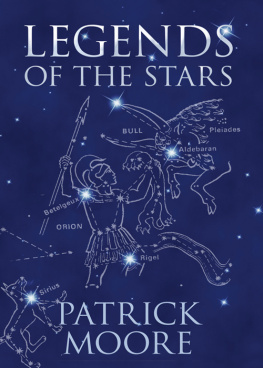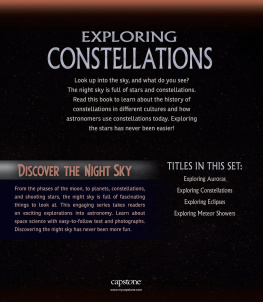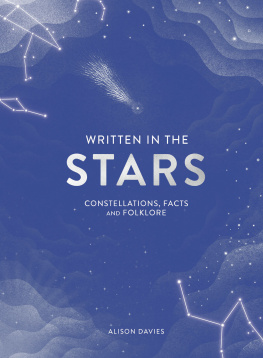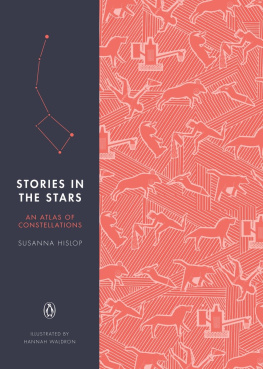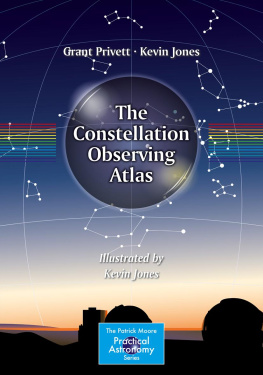Phil Simpson Patrick Moore's Practical Astronomy Series Guidebook to the Constellations Telescopic Sights, Tales, and Myths 10.1007/978-1-4419-6941-5_1 Springer Science+Business Media, LLC 2012
1. How To Use This Book
This book is designed to help a novice or advanced amateur astronomer learn the constellations, and to provide a source of information about celestial objects visible to the eye or in amateur instruments in each of the 88 constellations. I hope it will retain its usefulness long after the beginning amateur has learned the constellations. Toward this end, I have included some objects of interest which are easily viewed by the unaided eye, many of which are visible through binoculars or small telescopes, and a few of which require larger amateur telescopes to see or photograph. It is also designed to help an experienced amateur find the fainter and less well-known constellations and, to help answer the questions which visitors frequently ask at public star parties, like How do you find Scorpius, the Andromeda galaxy, or other celestial objects?
How you use this book will depend on how experienced you are with the constellations and amateur astronomy in general. A beginner may not know a single constellation and may not even know anyone who can help with finding the brighter constellations. The beginner should follow the instructions below. An experienced observer will (and is encouraged to) go directly to any constellation and use the detailed chart and object list for that constellation to find objects to observe. However, even a very experienced observer probably will not be familiar with all 88 constellations, or even with all the fainter constellations visible from his home. That observer can also benefit by locating the section covering the unknown constellation(s) and following the directions for finding the fainter constellations.
Although it is practical to begin the process of learning the constellations in any season by selecting one of the bright constellations visible at the time, the most logical way for most people in the northern hemisphere to start learning is to begin with the north circumpolar constellations. Not only are they familiar to most people in the form of the asterisms of The Big and Little Dippers, but they are visible to northern hemisphere observers at least part of the night all year long. The Big and Little Dippers are not constellations but asterisms which include only part of the constellations of The Big and Little Bears. The distinction is one of definition. A constellation is an area of the sky containing a group of stars which represent some figure or object and is officially recognized by the International Astronomical Union. An asterism consists of two or more stars which form some recognizable shape. An asterism may contain stars from only one constellation as does the Big Dipper, or stars from several constellations as do The Summer Triangle and The Winter Hexagon. Asterisms are in the eye of the beholder, and different people may see different asterisms in the same group of stars.
Once you are familiar with the circumpolar constellations, you can use them as guides or pointers to locate other constellations or bright stars which in turn will enable you to find surrounding constellations. No matter what time of the year you begin your study of the constellations, it is possible to find one or more bright, easily recognized constellations which can be located by extending lines from the two Dippers. In the winter there is Orion, one of the brightest and most easily recognizable constellations. During the spring, there is Leo with its first magnitude Regulus marking the handle of a scythe or the period at the bottom of a reversed question mark. In the summer, the three bright stars of Altair, Deneb and Vega form a large right triangle. Each is the brightest star in its constellation, Aquila, Cygnus, and Lyra, respectively. Autumns choices include the constellation of Cassiopeia and the asterism called the Great Square of Pegasus to guide you. The star at the northeast corner of the Great Square lies about 30 due south of Cassiopeiae. Although there are no first magnitude stars in Pegasus, first magnitude Fomalhaut lies in a relatively barren region of the sky, and thus stands out. A line drawn from Polaris, the pole star, due south to Fomalhaut passes along the western edge of the Great Square. The four stars of the Great Square are three rather average second magnitude stars and one third magnitude star, but they form a distinctive pattern about 15 on a side, oriented on an east/west and north/south direction. After these constellations are located, each one can be used as a guide for locating the surrounding constellations.
If you are already familiar with some of the constellations, or can find a friend or local astronomy club member willing to help you learn a few, you have a head start on learning as many as you wish because every constellation can be used as a guide to neighboring constellations, and these can be used to find even more until the entire set has been learned.
Southern hemisphere observers will need a slightly different procedure. Most of the constellations which are circumpolar for them will be very faint. These are not very helpful in finding other constellations. It will be better for inexperienced southern observers to start by finding one of the bright constellations like Crux (the Southern Cross), or an easily recognizable star or star group like Canopus, Alpha and Beta Centauri or Achernar. From those starting points, the fainter constellations can be found.
The Guidebook to the Constellations is organized so that each chapter (except )presents multiple constellations which are related to each other and which can be readily learned as a unit. For the 48 classical constellations, the relationship is defined by a common origin myth which explains the link between the constellations and why they are located near each other, or why they are in some particular pose or part of the sky. In the case of the constellations created by more modern astronomers, the link is usually their common creator(s). In a few cases, the creators were able to follow the ancient pattern and link the new constellation to an old myth or story, but this is usually not the case.
Although the Greek myths may at first seem to be unimportant, they have been carefully researched and selected to provide a significant amount of information about the constellations. Because these tales were old and retold by dozens or even hundreds of successive generations, many variations and elaborations arose. By carefully reviewing all the versions I could find, I was able to select the versions which include the largest number of constellations and incorporate the greatest amount of information about each group of constellations. An excellent example of this is the myth about Orion. In this case, tying together several strands of myths incorporates nine constellations into a single story. These constellations are divided into two groups, one visible in the summer and the other in the winter. This myth explains the presence of each constellation, why it is in a particular subgroup, why the two subgroups are visible only in their respective seasons, and why each constellation has a specific location relative to each of the others. It even explains why Orion is shown in a fighting stance, with his left hand holding his shield in front of him and his raised right hand holding a large club ready to strike.









